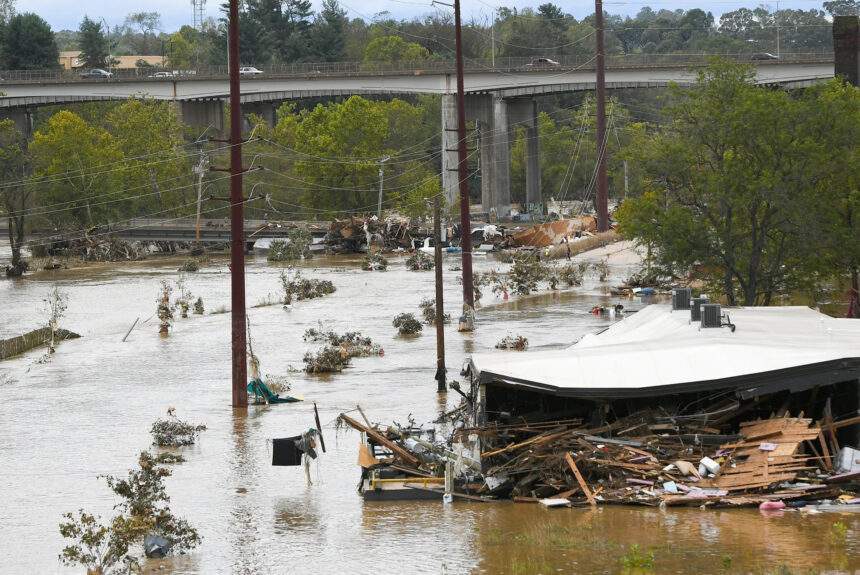Hurricane Helene hit the U.S. last week, leaving a wake of damage in its path. The three-day storm produced 40 trillion gallons of rainfall in the Southeast U.S.–enough to fill the Dallas Cowboys’ AT&T Stadium 51,000 times. At least 120 people have died from the storm, and over 1,000 have been reported missing in North Carolina’s Buncombe County alone.
>>>READ: Canada’s Wildfires: A Wake-up Call on the Need to Reduce Risk
With the storm passed, the hard work of disaster relief and recovery begins. As President Biden said to the press corps, “It’s going to take a hell of a long time and a serious amount of assets.” Modernizing regulations will help communities rebuild faster and make better use of taxpayer dollars.
Some of the worst damage from Helene is in Asheville, North Carolina. The city experienced flash floods, landslides, near dam collapses, and an estimated two feet of rain in some areas since Wednesday. The storm washed out I-40 and local roadways will likely remain closed for the foreseeable future. Some residents have been told by firefighters that it will be at least six months before they will see their homes again.
Meanwhile, the storm knocked out power for millions of homes in Georgia and the Carolinas, which is expected to last for days if not weeks. Duke Energy has stated that portions of western North and South Carolina will need to have their local grids completely rebuilt.
Lawmakers of the impacted states are pressing the federal government to pass emergency funding while Congress is out of session. While money will undoubtedly help the situation, America’s permitting and regulatory obstacles will hamper rapid relief efforts for Helene and hurricanes in the future. Whatever funding Congress passes, it can only go as far and as fast as regulations will allow.
Under the National Environmental Policy Act (NEPA), projects from highway expansions to power grid upgrades must complete years worth of comprehensive environmental assessments before they receive the green light to begin construction. Even then, a project can be tied up for years in litigation.
Under emergency circumstances, FEMA does not have to adhere to the usual NEPA review. However, the long-term response to an emergency, including recovery actions like bridge rebuilds, are subject to the normal NEPA process. Importantly, NEPA compliance is just one step in the process; agencies and developers must also satisfy requirements under federal and state regulations like the Clean Air and Clean Water Acts.
>>>READ: Perimeter Aims to Revolutionize Climate Disaster Evacuation
Ensuring clean air and clean water is essential, but the current regulatory structure is riddled with redundancies that add to project costs and timelines for marginal public health benefits. As first responders and nonprofit organizations race to provide aid, federal and state agencies have an opportunity to undo these redundancies. While a permanent fix to NEPA is ideal, other actions like expanding the list of categorical exclusions (CEs), which are actions that agencies can take without conducting an environmental review, are a great place to start. In the wake of Superstorm Sandy, the Department of Housing and Urban Development issued CEs for dune restorations, community park reconstructions, and economic revitalization efforts. FEMA and state agencies can build on this progress by expanding CEs and fast-tracking post-Helene reconstruction.
It’s unclear how long it will take to rebuild Western North Carolina’s traditional and grid infrastructure. However outdated and unclear regulations will almost certainly make the projects more expensive and slower to complete, but this doesn’t have to be the case. As Nick Loris wrote last year in the wake of the Baltimore Bridge collapse:
That is not to suggest that projects, whether they be a bridge or small modular nuclear reactor, should not meet a high bar for rigorous environmental and public safety standards. But when these standards hurt the health of the public and environment by delaying or killing important projects, it is time to reevaluate and fix this broken system. Policy reforms should empower project developers to meet that high bar faster. We can have the necessary transparency, oversight, and accountability without tying these projects in red tape and lawsuits for years. We have more knowledge, better tools, and access to data that should make it easier to build, not harder.
Helene is not the last hurricane that the U.S. will face, but it should be the last one whose response is mired by inefficient regulations. With the momentum for permitting reform growing on Capitol Hill, we can only hope that this is the case.
The views and opinions expressed are those of the author’s and do not necessarily reflect the official policy or position of C3.
